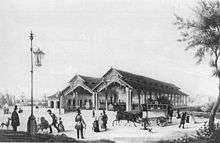Station building

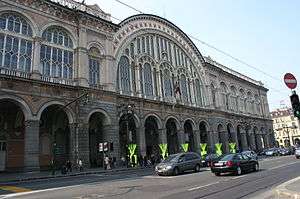
A station building, also known as a head house, is the main building of a passenger railway station. It is typically used principally to provide services to passengers.[1][2][3]
A station building is not to be confused with the station itself. Whereas the latter is the whole facility giving passenger access to trains at a particular location (and includes the tracks, platforms, and often also, e.g., a subway, train shed, etc.), a station building is a specific well-defined element of the station of which it forms part.
Normally, a station building will be of adequate size for the type of service that is to be performed. It may range from a simple single-storey building with limited services to passengers to a large building with many indoor spaces providing many services. Some station buildings are of monumental proportions and styles. Both in the past and in recent times, especially when constructed for a modern high-speed rail network, a station building may even be a true masterpiece of architecture.
A typical railway station building will have a side entrance hall off the road or square where the station is located. Near the entrance will be a ticket counter, ticket machines, or both. There will also be one or more waiting rooms, often divided by class, and equipped with seats and luggage stands. From the waiting rooms, there will usually be direct access to rail passenger services. Medium to large size station buildings will often also have offices for rail staff involved in the management and operation of trains. Smaller or more rural stations will have no station building at all.[4]
Architecture
Creation of the form
Several decades were needed to find a formula for station building architecture that would be easily recognizable in the urban space, like that of churches and town halls.
The first station buildings gave no special emphasis to their function, as they were essentially a variation on the house or office building. That makes it, for example, difficult to identify the function of the station building in the original Manchester terminus of the Liverpool and Manchester Railway or in the two railway stations in Vienna shown below, but they have been given the characteristics of a public building.
Often, the earliest station buildings were so modest that the main visible element of the station was the train shed such as for the first station in Mannheim.
Some early station building design teams tried to develop representative characteristics. Initially, this was by use of traditional architectural symbols, primarily related to the form of a "gate", such as a portico, a triumphal arch or Propylaea. But none of them (except perhaps the triumphal arch) have proved to be particularly suitable for expression of specific railway station functions.
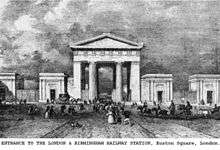 London Euston (1838): portico theme as a stand-alone gateway to the station square.
London Euston (1838): portico theme as a stand-alone gateway to the station square..jpg) Huddersfield (Yorks., England) (1850): palladian classicism with a portico.
Huddersfield (Yorks., England) (1850): palladian classicism with a portico..jpg) Stuttgart Central-Bahnhof (1868; right): a travesty of the triumphal arch motif.
Stuttgart Central-Bahnhof (1868; right): a travesty of the triumphal arch motif. Newcastle (England) (1850): a prominent portico.
Newcastle (England) (1850): a prominent portico.
One of the early ideas was to form the station building porticos to highlight the driveway and enlarge the scale of the dominant element of the facade. This motif is already present in the Newcastle Central station building (1850), then eagerly used in other stations in the UK. It became an even more prominent motif in the twentieth century, shaping the facade of the great railway station Milano Centrale.
In British railway stations, where - thanks to constant movement of trains - the exchange of passengers takes place rapidly, the practice is not to have large station buildings. To some extent, the railway hotel buildings (or sometimes railway board offices) serve part of the station's function. These structures do not reveal, however, many features of "railway stations". The one feature that can be found in many of them, worldwide, is a canopy over the driveway, usually made of iron (e.g. part of the former London Victoria LBSCR station).
The first two images in the following gallery are examples of the use of arcades (shelters) fitted to through station buildings. In their case, the arcade not only accentuates the station's public function, but also the complex's expansive, symmetrical shape.
- Augsburg Hauptbahnhof (1843): the iron arcade of one of the oldest surviving station buildings in Germany.
- Bologna Centrale (1873): columned arcade to the "Florence" palace.
 London Victoria (LBSCR) (1860): arcade from the station to the hotel building.
London Victoria (LBSCR) (1860): arcade from the station to the hotel building.- Bari Centrale (1874): broad facade with cartouche clock.
Among the attributes of the station, it is difficult to identify an element more appropriate than the station clock. Not everyone carried a wristwatch, so it was a necessity. It can be placed not only inside the station building, but also as a distinctive feature of the building's facade.
In countries not confined to the classical architectural tradition, station building designers soon began to use the theme of the clock tower, taken over from the town hall or church. This theme sometimes served more utilitarian purposes - there were also some water towers. The clock tower become particularly popular around the start of the 20th century. Along with a covered driveway, it may be a distinguishing characteristic of railway station buildings.
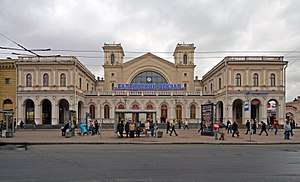
 Chicago Dearborn (or Polk St.) (1883): a station clock tower as the centre of the composition.
Chicago Dearborn (or Polk St.) (1883): a station clock tower as the centre of the composition. Limoges Bénédictins (1924): in the "Beaux-Arts" style with a clock tower.
Limoges Bénédictins (1924): in the "Beaux-Arts" style with a clock tower.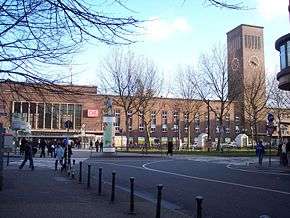 Düsseldorf Hauptbahnhof (1932): the clock tower in the crude style of "Neue Sachlichkeit".
Düsseldorf Hauptbahnhof (1932): the clock tower in the crude style of "Neue Sachlichkeit".
Over time, growing volumes of traffic prompted the construction of the railway stations of increasing scale. More and more stations also satisfied the ambitions of the city, railway boards, and countries whose railways have had to shape an appropriate image of the country.
Around the start of the 20th century, a trend towards the deliberate use of architectural forms which give large and high spaces, often modeled on classical forms from the Roman Empire.
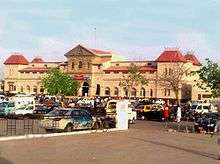 Karachi Cantonment Railway Station (1898): subcontinental grandeur.
Karachi Cantonment Railway Station (1898): subcontinental grandeur.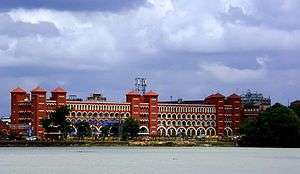 Howrah railway station (1854): the main terminal building.
Howrah railway station (1854): the main terminal building.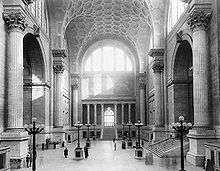 New York Pennsylvania Station (1908): the entrance hall (demolished 1968).
New York Pennsylvania Station (1908): the entrance hall (demolished 1968).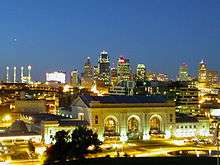 Kansas City Union Station (1914): renovated for new uses.
Kansas City Union Station (1914): renovated for new uses. Milano Centrale (designed 1913).
Milano Centrale (designed 1913).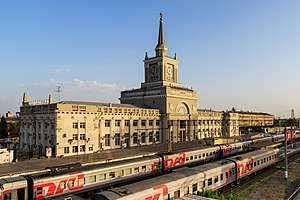 Volgograd (formerly Stalingrad).
Volgograd (formerly Stalingrad).- Kharkiv, Ukraine (1952).
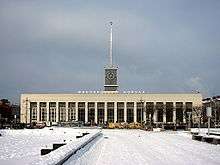 St Petersburg (formerly Leningrad), Finlyandsky Rail Terminal (1960).
St Petersburg (formerly Leningrad), Finlyandsky Rail Terminal (1960).
Small stations
Small local stations have been built in a variety of stylistic forms.
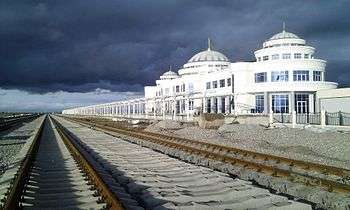 Bereket city railway station, Turkmenistan.
Bereket city railway station, Turkmenistan.- Great Kills (New York City, built 1933): Brick station house sits above platforms with entrance at street level
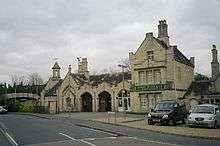 Stamford (Lincs., Eng; 1846): Tudor style - one of the forms of romantic British railway stations.
Stamford (Lincs., Eng; 1846): Tudor style - one of the forms of romantic British railway stations.- Złotów (Poland, 1870s): German Romantic style.
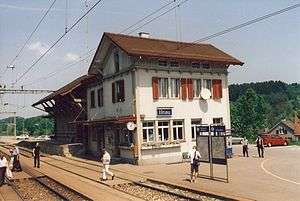 Illnau (Switzerland): Alpine style, with a distinctive "Tyrolean" roof (over the goods shed).
Illnau (Switzerland): Alpine style, with a distinctive "Tyrolean" roof (over the goods shed).- Jedlová (Czech Republic): building with arcades typical of the Austro-Hungarian Empire.

 Pabianice (Poland, 1903): Neo-renaissance with "familiar" roof.
Pabianice (Poland, 1903): Neo-renaissance with "familiar" roof. Padrón (Galicia, Spain): Neo-renaissance; form typical of many stations in Spain, France, Italy.
Padrón (Galicia, Spain): Neo-renaissance; form typical of many stations in Spain, France, Italy. Perugia Sant'Anna (Perugia, Italy; 1920): Neo-renaissance, Italian Stile Liberty.
Perugia Sant'Anna (Perugia, Italy; 1920): Neo-renaissance, Italian Stile Liberty. Middletown (New York; 1897) characteristic of the U.S. spreading roof, neo-Romanesque style.
Middletown (New York; 1897) characteristic of the U.S. spreading roof, neo-Romanesque style.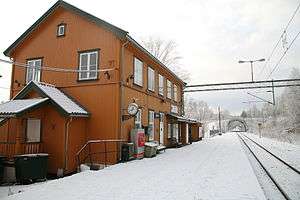 Røyken (Norway; 1872?): a simple Scandinavian wooden station building.
Røyken (Norway; 1872?): a simple Scandinavian wooden station building. Białowieża (eastern Poland; 1897?): wooden building in the eastern European tradition.
Białowieża (eastern Poland; 1897?): wooden building in the eastern European tradition.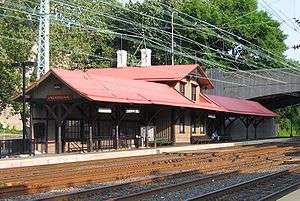 Overbrook (Philadelphia; 1858, rebuilt 1880s), one of the oldest in America.
Overbrook (Philadelphia; 1858, rebuilt 1880s), one of the oldest in America.- Taisha (Japan; 1924): traditional Japanese wooden station.
Other elements of station architecture
Railway station architecture is not just the architecture of the station building. It includes the design of separate platforms and canopies, or the train shed (i.e. an overall canopy for the platforms and tracks), if any. Also, shelters can impart the characteristic face of the station and be more than a utilitarian form of construction.
Architects also create railway station towers, and buildings and equipment associated with the movement of trains: control rooms, and even signals, sometimes grouped together on the platforms over the tracks. The continued existence of these objects, especially the control room, is sometimes at risk when traffic safety technologies are updated.
 Tynemouth (England): platforms and canopies.
Tynemouth (England): platforms and canopies.- Crawley (England): signal box
 Oldenburg (Germany): water tower.
Oldenburg (Germany): water tower.- Würzburg Hbf (Germany): signal gantry.
See also
- Airport terminal
- Railway station layout
References
- ↑ Meeks, Carroll L.V. The railroad station: An architectural history (1956).
- ↑ Middleton, William D., George M. Smerk, and Roberta L. Diehl, eds. Encyclopedia of North American Railroads. (Indiana University Press, 2007). pp 126-44
- ↑ Jeffrey Richards, and John M. MacKenzie. The Railway Station: A social History (1986).
- ↑ Middleton, Encyclopedia of North American Railroads. (2007). pp 126-44
Books
A bibliography of the history and design of railway stations could be very extensive. In almost all countries where there is a railway system, at least one book has been published on the national fusion of architecture around the railway station.
Synthesis of trans-national literature (selection):
- Edwards, Brian (1997). The Modern Station: New Approaches to Railway Architecture. London: E & FN Spon. ISBN 0-419-19680-3.
- Kubinszky, Mihály (1969). Bahnhöfe Europas (in German). Stuttgart: Franckh'sche Verlagshandlung.
- Meeks, Carroll L.V. (1956). The Railway Station. An Architectural History. New Haven: Yale University Press. (also (1957). London: Architectural Press)
- Parissien, Steven (1997). Station to Station. London: Phaidon. ISBN 0-7148-3467-X.
- Ross, J (ed) (2000). Railway Stations. Planning, design and management. Oxford: Architectural Press. ISBN 0-7506-4376-5.
- Richards, Jeffrey; MacKenzie, John M. (1986). The Railway Station. A Social History. Oxford: Oxford University Press. ISBN 0-19-215876-7.
National and regional synthesis (selection):
- Biddle, Gordon (1986). Great Railway Stations of Britain. Newton Abbott: David & Charles. ISBN 0-7153-8263-2.
- Biddle, Gordon; Nock, O.S.; et al. (1983). The Railway Heritage of Britain. 150 Years of Railway Architecture and Engineering. London: Michael Joseph. ISBN 0-7181-2355-7.
- Biddle, Gordon (1973). Victorian Stations. Newton Abbott: David & Charles. ISBN 0-7153-5949-5.
- Condit, Carl W. The Port of New York: A History of the Rail and Terminal System from the Beginnings to Pennsylvania Station. (University of Chicago Press, 1981).
- Meeks, Carroll L.V. The railroad station: An architectural history (1956).
- Middleton, William D., George M. Smerk, and Roberta L. Diehl, eds. Encyclopedia of North American Railroads. (Indiana University Press, 2007). pp 126–44
- Middleton, William D. Grand Central, the World's Greatest Railway Terminal (Golden West Books, 1977).
- Potter, Janet Greenstein (1996). Great American Railroad Stations. Washington, D.C.: Preservation Press. ISBN 0-471-14389-8.
- Richards, Jeffrey, and John M. MacKenzie. The Railway Station: A social History (1986).
- Horváth, Ferenc; Kiss, Zsuzsanna; Kubinszky, Mihály; Vörös, Tibor (1999). The Architecture and the Hungarian Railway. Budapest: MÁV. ISBN 963-03-7927-9.
- Jackson, Alan A. (1969). London's Termini. Newton Abbott: David & Charles.
Other languages
- Aguilar, Inmaculada; Palacio, Pedro Navascués; Bustamante, Alberto Humanes; et al. (1980). Estaciones Ferroviarias de Madrid. Su arquitectura e incidencia en el desarrollo de la ciudad (in Spanish). Madrid: Colegio Oficial de Arquitectos de Madrid.
- Godoli, E.; Cozzi, M. (eds) (2004). Architettura ferroviaria in Italia. Ottocento (in Italian). Palermo: Dario Flaccovio Editore. ISBN 88-7758-599-4.
- Godoli, E.; Lima, A. I. (eds) (2004). Architettura ferroviaria in Italia. Novecento (in Italian). Palermo: Dario Flaccovio Editore. ISBN 88-7758-597-8.
- Berger, Manfred (1980–96). Historische Bahnhofsbauten. I–IV. Berlin (O): Transpress. ISBN 3-344-00066-7. ISBN 3-344-00067-5, ISBN 3-344-00267-8, ISBN 3-344-71029-X (in German)
- Krejčiřík, Mojmír (2003-04). Česká nádraží. Architektura a stavební vývoj (in Czech). I–II. Litoměřice: Vydavatelství dopravní literatury. ISBN 80-902706-8-9. Check date values in:
|year=(help) - Kubinszky, Mihály; Gombár, György (1989). Bahnhöfe in Ungarn 1846-1988 (in German). Budapest: MÁV. ISBN 963-316-267-X.
- Lamming, Clive (1999). Paris ferroviaire (in French). Parigramme. ISBN 2-84096-115-6.
- Romers, Dr H (1981). De Spoorwegarchitektuur in Nederland 1841-1938 (in Dutch). Zutphen: De Walburg Pers. ISBN 90-5730-090-7.
- Stutz, Werner (1983). Bahnhöfe der Schweiz. Von den Anfangen bis zum Ersten Weltkrieg (in German). Zürich: OrellFüssli. ISBN 3-280-01405-0.
- 杉崎行恭 (Yukiyasu Sugizaki) (2000). 駅舎再発見―時代の姿をとどめる駅舎を訪ねて (Ekisha saihakken. Jidai-no sugata-o todomeru ekisha-o tazunete) (in Japanese). Tōkyō: JTB. ISBN 4-533-03675-9.
External links
| Wikimedia Commons has media related to Station buildings. |
- Railway Stations - Blog dedicated to railway stations worldwide - Poland
- Serwis KOLEJ.pl - Infrastruktura - Poland
- - Most beautiful railway stations in Poland TOP 10 - Poland
- Wichor Bramer, www.stationsweb.nl - Nederlands grootste online verzameling stationsphoto's (The Netherlands' greatest online collection of station photos) - Netherlands
- Guy Demeulder, Les gares belges d'autrefois - The stations of Belgium and elsewhere - Belgium
- La Estación de tren - Railway stations - Spain
- Ralph Mennucci Giesbrecht, Estações Ferroviárias Railway stations - Brazil
- Jean-Paul Foitet Il était une fois les gares! Le site de l'Architecture Ferroviaire - (Once upon a time there were railway stations! The railway architecture site) - France
- HisaAi, Hisakyū Tetsudō Shōkai - Japan
- Manche - Océan (Channel - Ocean) - France, PO-Etat railway
- Verkehrswerkstatt, Bahnhöfe (Stations) - Germany
The lead section of this article is based upon a translation of the Italian-language version as at January 2011. The rest of the article is based upon a translation of part of the Polish-language version, and is currently a work in progress.


